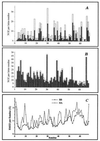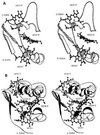NMR characterization and solution structure determination of the oxidized cytochrome c7 from Desulfuromonas acetoxidans
- PMID: 8962062
- PMCID: PMC26143
- DOI: 10.1073/pnas.93.25.14396
NMR characterization and solution structure determination of the oxidized cytochrome c7 from Desulfuromonas acetoxidans
Abstract
The solution structure of the three-heme electron transfer protein cytochrome c7 from Desulfuromonas acetoxidans is reported. The determination of the structure is obtained through NMR spectroscopy on the fully oxidized, paramagnetic form. The richness of structural motifs and the presence of three prosthetic groups in a protein of 68 residues is discussed in comparison with the four-heme cytochromes c3 already characterized through x-ray crystallography. In particular, the orientation of the three hemes present in cytochrome c7 is similar to that of three out of four hemes of cytochromes c3. The reduction potentials of the individual hemes, which have been obtained through the sequence-specific assignment of the heme resonances, are discussed with respect to the properties of the protein matrix. This information is relevant for any attempt to understand the electron transfer pathway.
Figures





Similar articles
-
A proton-NMR investigation of the fully reduced cytochrome c7 from Desulfuromonas acetoxidans. Comparison between the reduced and the oxidized forms.Eur J Biochem. 1999 Dec;266(2):634-43. doi: 10.1046/j.1432-1327.1999.00904.x. Eur J Biochem. 1999. PMID: 10561607
-
A quick solution structure determination of the fully oxidized double mutant K9-10A cytochrome c7 from Desulfuromonas acetoxidans and mechanistic implications.J Biomol NMR. 2002 Feb;22(2):107-22. doi: 10.1023/a:1014202405862. J Biomol NMR. 2002. PMID: 11883773
-
800 MHz 1H NMR solution structure refinement of oxidized cytochrome c7 from Desulfuromonas acetoxidans.Eur J Biochem. 1998 Sep 1;256(2):261-70. doi: 10.1046/j.1432-1327.1998.2560261.x. Eur J Biochem. 1998. PMID: 9760163
-
Individual redox characteristics and kinetic properties of the hemes in cytochromes c3: new methods of investigation.Biochimie. 1994;76(6):524-36. doi: 10.1016/0300-9084(94)90176-7. Biochimie. 1994. PMID: 7880891 Review.
-
Recent advances in the characterization of the hexadecahemic cytochrome c from Desulfovibrio.Biochimie. 1994;76(6):561-8. doi: 10.1016/0300-9084(94)90180-5. Biochimie. 1994. PMID: 7880895 Review.
Cited by
-
Biochemical and genetic characterization of PpcA, a periplasmic c-type cytochrome in Geobacter sulfurreducens.Biochem J. 2003 Jan 1;369(Pt 1):153-61. doi: 10.1042/BJ20020597. Biochem J. 2003. PMID: 12356333 Free PMC article.
-
Genome-resolved metagenomics identifies genetic mobility, metabolic interactions, and unexpected diversity in perchlorate-reducing communities.ISME J. 2018 Jun;12(6):1568-1581. doi: 10.1038/s41396-018-0081-5. Epub 2018 Feb 23. ISME J. 2018. PMID: 29476141 Free PMC article.
-
The metal reductase activity of some multiheme cytochromes c: NMR structural characterization of the reduction of chromium(VI) to chromium(III) by cytochrome c(7).Proc Natl Acad Sci U S A. 2002 Jul 23;99(15):9750-4. doi: 10.1073/pnas.152290999. Epub 2002 Jul 15. Proc Natl Acad Sci U S A. 2002. PMID: 12119407 Free PMC article.
-
First evidence for the presence of a hydrogenase in the sulfur-reducing bacterium Desulfuromonas acetoxidans.J Bacteriol. 1999 Sep;181(17):5505-8. doi: 10.1128/JB.181.17.5505-5508.1999. J Bacteriol. 1999. PMID: 10464227 Free PMC article.
-
The Desulfuromonas acetoxidans triheme cytochrome c7 produced in Desulfovibrio desulfuricans retains its metal reductase activity.Appl Environ Microbiol. 1998 Apr;64(4):1308-12. doi: 10.1128/AEM.64.4.1308-1312.1998. Appl Environ Microbiol. 1998. PMID: 9546165 Free PMC article.
References
-
- Ambler R P. In: From Cyclotrons to Cytochromes. Robinson A B, Kaplan N O, editors. London: Academic; 1980. pp. 263–279.
-
- Pettigrew G W, Moore G R. Cytochromes C: Biological Aspects. Berlin: Springer; 1987.
-
- Haser R, Pierrot M, Frey M, Payan F, Astier J P, Bruschi M, LeGall J. Nature (London) 1979;282:806–810. - PubMed
-
- Pierrot M, Haser R, Frey M, Payan F, Astier J P. J Biol Chem. 1982;257:14341–14348. - PubMed
-
- Higuchi Y, Kusunoki M, Matsuura Y, Yasuoka N, Kakudo M. J Mol Biol. 1984;172:109–139. - PubMed
Publication types
MeSH terms
Substances
LinkOut - more resources
Full Text Sources
Miscellaneous

